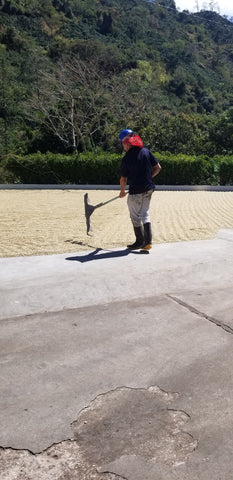From start to finish, a lot of work goes into producing that steaming cup of coffee you crave as soon as you wake. From growing to picking, processing, roasting and flavoring, we're here to give you a brief overview of how our favorite beverage goes from a cherry to that delicious elixir of life we call coffee.

I had the great pleasure of visiting Hacienda La Minita, a stunningly beautiful coffee farm located in the Tarruzu region of central Costa Rica. Since this farm produces my all time favorite coffee, our Costa Rica La Minita , I was excited to see firsthand how they produce such amazing coffee.
Coffee Trees
Coffee is grown on trees that average 6-15 ft tall when mature. Coffee trees need to be grown in warm, tropical and subtropical climate, so you can find them in countries like Brazil, Ethiopia, Colombia, Indonesia and my personal favorite, Costa Rica. Most aren't very big in height, making it easier to reach all the branches when picking the coffee cherries.

Arabica coffee tree in Costa Rica
Coffee Cherries
While you're used to hearing the words coffee bean, coffee actually starts out as a cherry! Inside this cherry are two seeds which we call the beans.

Coffee cherries picked at Hacienda La Minita in February 2019 by the CB team
Picking and Processing
There is typically only one harvesting time per year (October-March), lasting about 2-3 months as the cherries ripen.
As the best specialty coffee (like the ones that we use) is grown at high altitudes, it's not uncommon to find picking happening on mountainsides.
Each day after the workers pick the coffee, they take it to a weigh station where they are paid for their hard work. The coffee is then taken to a processing plant where it is immediately processed, most of the time in the very same night! The outer fruit is removed through a series of washing.

One of the processing machines used to remove the coffee bean from the outer cherry fruit.
When the outer cherry is removed and we're left with the green beans that are inside the cherry, the beans are moved to a holding tank before heading off to the dryer.

Green coffee bean holding tanks
In order to dry the beans, they are either placed in tumble dryers, similar to a clothes dryer or dried on sun-drenched patios and are constantly turned to better reduce the moisture content.


Drying green coffee beans
Roasting
The dried, green beans are imported to our roasting facility in Flushing, MI and stored in burlap bags until ready to be roasted

Green coffee beans waiting to be roasted
We have three roasters including a 240 kilo (approx 529 lbs), a 12 kilo roaster (approx 26 pounds) where we roast single origin coffees and a 1 pound roaster for testing new coffee crops.
Our 240k roaster
Coffee Beanery is unique in our roasting process in that we use our patented Right Roast process, meaning we don't just press a button for a French roast or light roast coffee. Instead, we meticulously scrutinize each crop that arrives to ensure that each coffee is roasted the right way, every time. This process helps us achieve an accurate and exemplary flavor with every bag you buy.

Flavoring
After roasting and degassing, all unflavored coffee is packaged and shipped out. However if the beans are slated for flavoring, they are taken to our flavoring station where they are spun in flavoring oils before being packaged.

Grinding and Brewing
At this point, our coffee has taken quite the journey, but we're finally at the best part; you enjoying every sip!
Some of our customers prefer to buy their beans from us whole so they can grind them at home, while others have us grind them with our professional grade burr grinders. For more on grinding and what type you need, check out our blog here.
Our packaging allows your coffee to stay fresh in its unopened bag for up to a year but once you open it, it's best to enjoy within 2 weeks for optimum freshness and flavor. Also be sure to store your coffee in an airtight container, away from heat and light.
When it's time to brew, here are a few quick tips to give you the best taste:
- Use fresh, cold filtered water.
- Wet the paper filter before brewing.
- Grind your beans immediately before brewing.
- For every cup of water, use 1 tablespoon of ground coffee
We hope you enjoyed reading about all the care and quality that goes into every cup of our coffee that our small family business has been perfecting since 1976!










